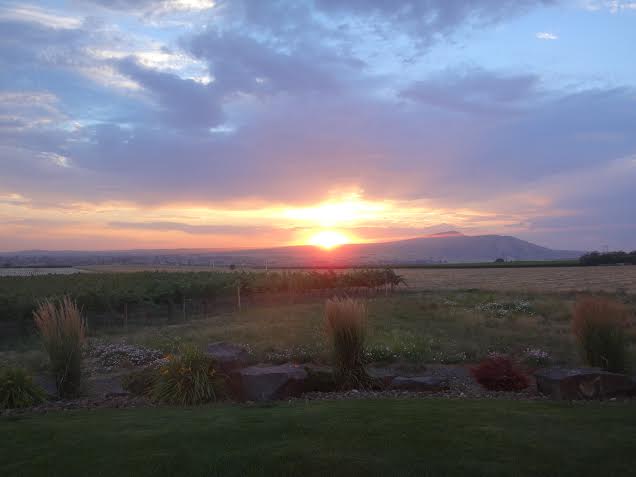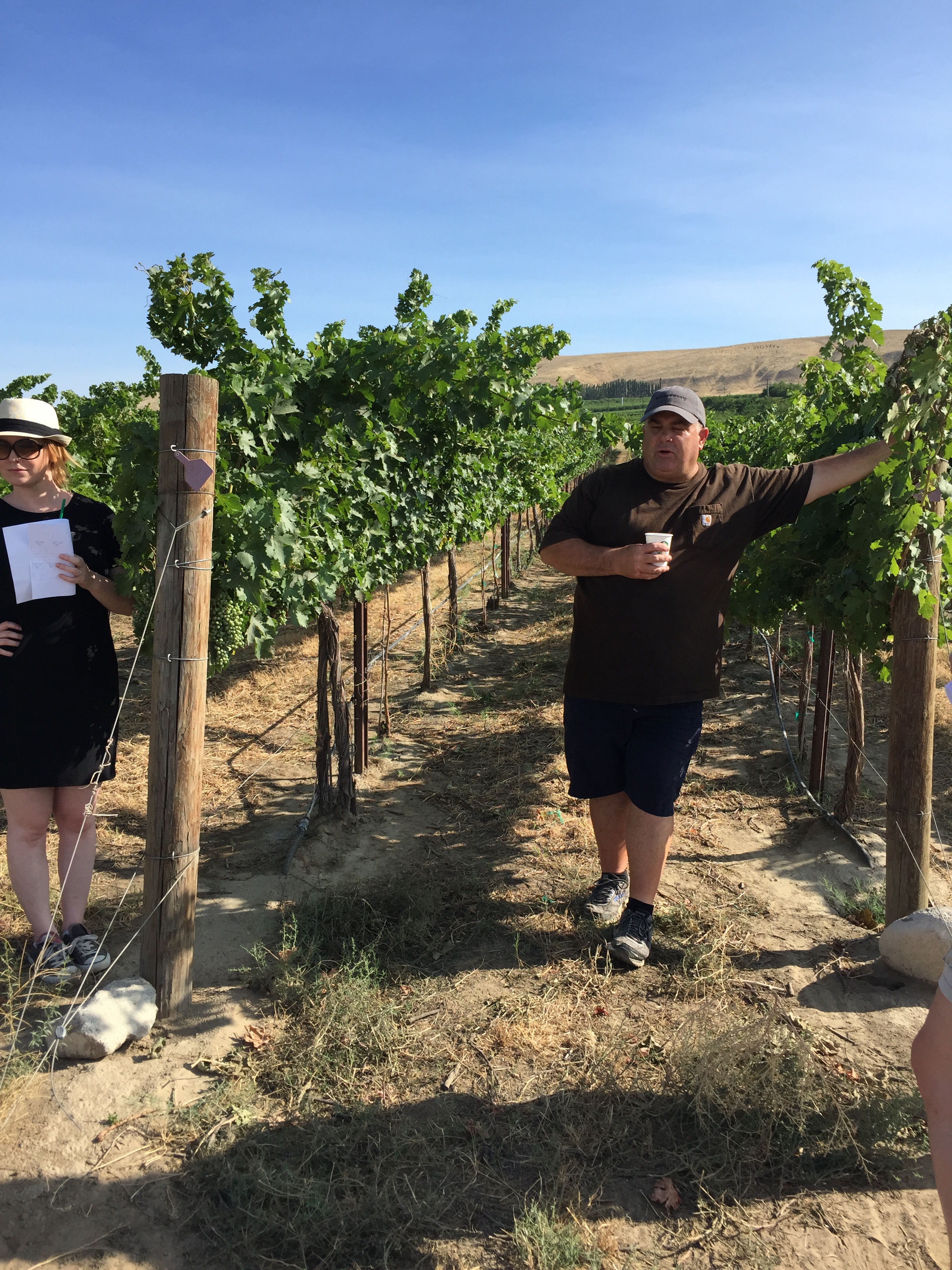Fidelitas Staff Retreat 2015 - Inland Desert Nursery
To say that we are in love with our new baby vines might be an understatement. This spring, as we planted our Estate Vineyard, the staff at Fidelitas anxiously awaited any new information and pictures coming from Charlie and the Vineyard crew. The road was marked? End posts delivered? IRRIGATION? What’s getting planted today? Are they greenhouse plants? Dormant rootings? Who knew we could be so excited.
When planning our Staff Retreat this year, visiting Inland Desert Nursery was perhaps the most requested activity. Team Fidelitas wanted to see where it all begins. We wanted to see the grafting and dormant vines, and tiny, tiny plants. To us, this was thrilling, so we were pretty excited when Ryan welcomed us in (I think we may have been the first group who actually wanted a tour). Inland Desert is a family owned and run operation dedicated to propagating and distributing clean vines (we’ll come back to that later) across North America. Based between Benton City and Prosser, they do much more than just Washington vineyards and send plants to more than 30 states.
At the risk of going on and on about baby vines, I’ll try to summarize what I learned that day:
Inland Desert works with the Clean Plant Center to ensure that all vines are CLEAN. This means that the vines they are working with have been certified as free from targeted viruses. Since wine grapes are propagated via cuttings, it is so, so important to make sure that they are virus free, otherwise these viruses can spread quickly, affecting entire vineyards.
They sell more grape varieties and clones than I knew existed. I’ve gone through my Sommelier training, plus some other wine coursework, and read a million wine books, and they have grapes I’ve never heard of before (Kay Gray?). If they don’t have it, they’ll find it for you. The catalog these guys carry around looks like a phone book. Remember, a grape varietal (eg. Cabernet Sauvignon) can have many, many clones. We have 3 Cabernet Clones planted in the original 2009 planting and 5 in the 2015 planting. Clones are genetically identical but offer different characteristics, like earlier ripening, looser grape clusters, more tannins. Think of it like identical twins but one is taller and can run a little faster.
cuttings from the mother plant
The talented staff has many ways of giving us little vines. As you know, there has been A LOT of planting on Red Mountain this year, which meant that we got to plant dormant rootings and green potted plants. In Washington, we have a low presence of phylloxera (a tiny little louse that likes to nibble on the roots and nearly wiped out France in the late 19th century), mostly due to our sandy soils, which these critters don’t like, so we can plant vines on their own rootstock. However, areas like Oregon and California battle it a bit more so they need to have vines grafted on to a rootstock that is phylloxera resistant. Here is the coolest part: to grow a new plant, they get a stick of an old plant (a mother plant) and stick it in the dirt. That stick starts growing and once it has two buds, they clip it, put that new stick into dirt, and it starts growing. That mother plant just keeps going and going and going (as good mamas do) and pretty soon you have a greenhouse full of little vines.
red mountain bound merlot
There is so much more to learn about this whole process. If you are at all interested, I’d highly recommend checking out the Inland Desert Nursery website (and searching for the amazing Charlie picture while you’re there).
Fidelitas Staff Retreat 2015 - Quintessence Vineyard
Following our tour of the Estate Vineyard we departed from the tasting room and headed on our vineyard tour towards the 300 acres that makes up the Quintessence Vineyard.
The original 68 acres were planted in 2010. Of these 68 acres Fidelitas sources about 6 acres of Cabernet Sauvignon. We are sourcing clone 191 and clone 8 from block 9 and 10. The second phase of the vineyard was planted in 2012 and the third phase planted in the spring of 2014. Quintessence is owned by Dick Shaw and Paul Kaltinick who enlisted, Eric Henriksen as General Manager and Marshall Edwards as Vineyard Operations Manager.
Marshall Edwards has played a large role in the industry for several years, having managed vineyards for Ste. Michelle and Canoe Ridge that portray a similar steep terrain to Quintessence. Marshall was kind enough to meet up with us on the Eastern ridge, where we were able to see the most current plantings. Then, Marshall pointed out that sand, basalt and hezel are the predominant soil types at the Quintessence Vineyard and you can see several rock piles scattered about that had to be cleared to plant the vineyard.
“It is such an honor to work with Charlie and have Fidelitas be in the vineyard.”
For those of you wanting a sneak peak of Quintessence, you can find that about 47% makes up the 2012 OPTU Red Mountain. The 2012 Quintessence Cabernet Sauvignon will be featured in Seattle Met Magazine as a top 100 wine and received a score of 91 points by the Wine Advocate. The wine is soon to be released in September and showcases not only the Quintessence Vineyard but also clone 169 and 171.
From here were able to experience the spectacular views and examine the slopes of the land as well as, the giant rock that Team Fidelitas loves to take our annual photo on.

Fidelitas Staff Retreat 2015- Estate Vineyard
Fidelitas Staff Retreat 2015 kicked off with coffee and a light breakfast before venturing out into the Red Mountain Vineyards. Charlie’s tour started in our back yard, with our 2008 planting of Cabernet Sauvignon.

The original portion of the Estate vineyard was planted in 2008. The entire area was planted in Cabernet Sauvignon, consisting of three blocks which included Cabernet Clone 2, Clone 8, and Clone 6. As a winemaker, Charlie loves the flavor of the Clone 6 Cabernet. This particular clone isn’t quite as popular from a grower perspective because of its smaller, scattered cluster size and lower yield. However, from his position as a winemaker and a vineyard owner, Charlie decided it was worth sacrificing a lower production with a clone that produced amazing flavors. When planning the next portion of the Estate Vineyard, he decided to expand the Clone 6 portion of the earlier planting.
2012 was our first harvest from these blocks, and we are excited to be releasing an Estate Cabernet later this fall that consists of the Clones 2 and 6. Our currently released Optu Red Wine also includes some the Clone 8 Cabernet as well.
While in the more established portion of the vineyard, Charlie explained the art of canopy management which is especially important this year with its early, unseasonably hot weather. Our vineyard crew works hard to ensure that there is a balance between the amount of fruit hanging on the vine versus the amount of leaves available to supply the needed energy for the grapes to ripen and develop properly. They must also ensure that the canopy is shading the young grapes to protect them from the harsh Red Mountain heat and sun, while they are also receiving enough sun and heat to ripen properly. That’s quite the job this time of year!

Charlie then guided out of the shade and into the newly planted portion of the Estate Vineyard. Most of the 2015 planting is Cabernet Sauvignon. The Cabernet blocks include more of Clone 6, as well as Clone 33, Clone 2, and Entave Clone 169. Charlie also decided to plant a Cabernet Clone that he was introduced to by a fellow winemaker, Clone 412. Very little of this clone is planted elsewhere in Washington, but Charlie who is always in search of a better, more balanced wine, decided to plant over ¾ of an acre of this clone to give it a try.
The new planting also includes a 1.6 acre block of Merlot, over an acre of Petit Verdot, and smaller blocks of Malbec, and Cabernet Franc. Because of the large demand for vines this spring, a portion of the new vineyard, including all of the Cabernet Franc, was greenhouse potted plants instead of strictly stick root stock. It was interesting to see that while the potted plants had an obvious head start, the rest of the plantings were thriving!



I’m lucky enough to spend most of my days watching the daily routine of the vineyard and enjoying the progression from bud break to harvest every year. We speak to our guests on a daily basis on the work, planning, patience, and love that goes into our young vineyard. I’m so thankful for every opportunity I have to walk through the vineyard with Charlie and Dick and learn even more about the place I get to call home.

The Importance of Employee Education
Over the past couple of years Fidelitas has taken a couple of days during the peak of the growing season and brought together all of our tasting room and wine club personnel The main function of these two days together is to continually educate our staff on everything related to Fidelitas. We recently completed our 2015 staff retreat on Red Mountain on July 7th & 8th.
Our goal at Fidelitas, is to provide to you as a consumer with a great experience each and every time you visit us either at our home on Red Mountain or at our location in Woodinville. We often discuss having an authentic experience when you visit us. In order for this to occur the people that are pouring our wines need to have a level of knowledge that makes them Fidelitas experts. Our tasting room employee’s become the face of our winery and are responsible for telling the authentic Fidelitas story. When our story is shared with each and every one of you as consumer’s then the wine that you are tasting takes on a whole new meaning.
Over the course of the two days we spend together we hope to enlighten our people with information that will hopefully, make them not only experts on Fidelitas but have a more than average awareness of Red Mountain and the factors that make it a unique place to grow grapes and make wine. We expect our people to know what a clone is and what clones we have planted in our estate vineyard. We expect them to know what makes Red Mountain such a great place to grow grapes. We expect them to know where different vineyards are that we make wine from. The list goes on and on.
The two days we spend together here on Red Mountain are invaluable in educating the people that each of you meet when you visit Fidelitas. Hopefully this provides a more authentic experience for you as a consumer of our wines. Hopefully it also makes for a more interesting place for members of our team to work.


Avocado Turkey Burgers
In the spirit of summer and America, I decided to create a crowd favorite…burgers. When it comes to summer it would not be complete without BBQs, burgers and the Boushey Red Wine. This is my take on the classic hamburger with a delicious upgrade.
The Turkey Burger
First, mixed a pound of ground turkey or the ground meat of your choosing, one egg, bread crumbs, balsamic vinegar, some fresh herbs (I used rosemary), red pepper flakes a drizzle of olive oil, and some salt and pepper. Then, make them into patties and grill them on the BBQ until cooked. I also topped mine with a slice of Beecher’s Flagship.
.jpg)
The Dressing
Then, in a small bowl mix olive oil, Dijon mustard, salt and pepper, lemon juice and fresh herbs. I gave this a quick stir and tossed it over a nice spring mix of lettuce.
The Final Product
I am a firm believer in using what you have on hand while cooking but for this particular meal I would suggest gathering all ingredients, the flavors came together so nicely. Top a ciabatta bun with a little mayo, mustard and ketchup. Then, place the patty down on the bun and finish with slices of avocado, fresh tomatoes, onions, and finish with a mound of the dressed up lettuce.
This is a great addition for a night in or serve it amongst friends while pairing it with the
2011 Boushey Vineyard Red Wine.
Words From A Loyal Fidelitas Member
When we hear things like this from our members, we just have to share them with you! We welcome guest writer/blogger and beloved Club member Melinda Knapp to the Fidelitas Blog. This is what Melinda had to say about our most recent event...
"They say that “membership has its benefits”, at least according to American Express. The same could be said for being a member of the Fidelitas family. I have been a wine club member at Fidelitas for a little over 7 years. I’ve attended numerous events not only at their winery on Red Mountain, but also at their tasting room in Woodinville. They have always been well thought out and enjoyable! This year’s Magna Dinner on Red Mountain was no exception. We braved the triple digit temps this past weekend and drove over the hill because I knew we had a treat in store for us.
Saturday morning started off with a very informative tour of the estate vineyard, so we could see firsthand the new plantings. Hearing Charlie talk about the different clones that were planted makes me very excited for the future of Fidelitas wines! There is even a row in the estate vineyard with each clone planted right next to each other, so that as they grow and mature you will be able to see the differences in the vine and the fruit. Very cool and educational.
Dinner that evening was thoughtfully moved inside in the A/C, as the temps outside at 7:00pm were still in the mid-90s. The tables were dressed simply with these really cool centerpieces of baby vines. There were some passed appetizers to start, served with the newly release 2014 Semillion. The crispy purple cauliflower was my favorite. The salad course was a farmer’s market feast with greens, peas, radishes and asparagus. It paired beautifully with the 2014 Optu White. Our main course had a lovely selection of grilled meats and vegetables along with a very unique and tasty squash and farro bake. With those we sipped on Champoux Magna Red Blend, Optu Red & Red Mountain Cabernet Sauvignon all from the 2012 vintage. Then we watched the sun set over the estate vineyard creating this beautiful orange and pink canvas on the sky. A perfect end to a perfect evening. Thank you again Fidelitas for treating me and all your wine club members like family."



Thank you to Melinda and the rest of our loyal members! We cant wait for the next event here at Fidelitas.













